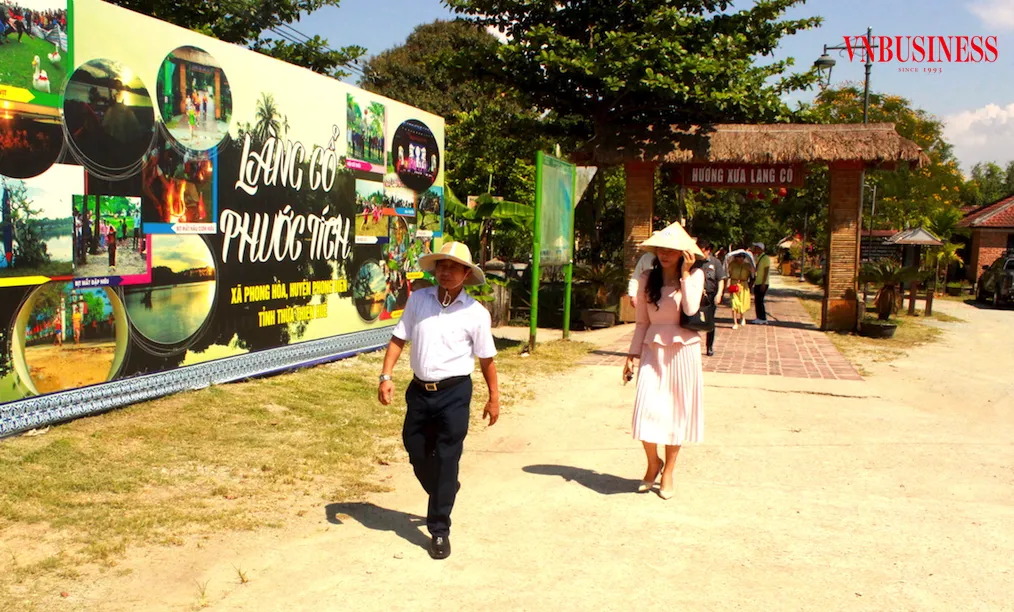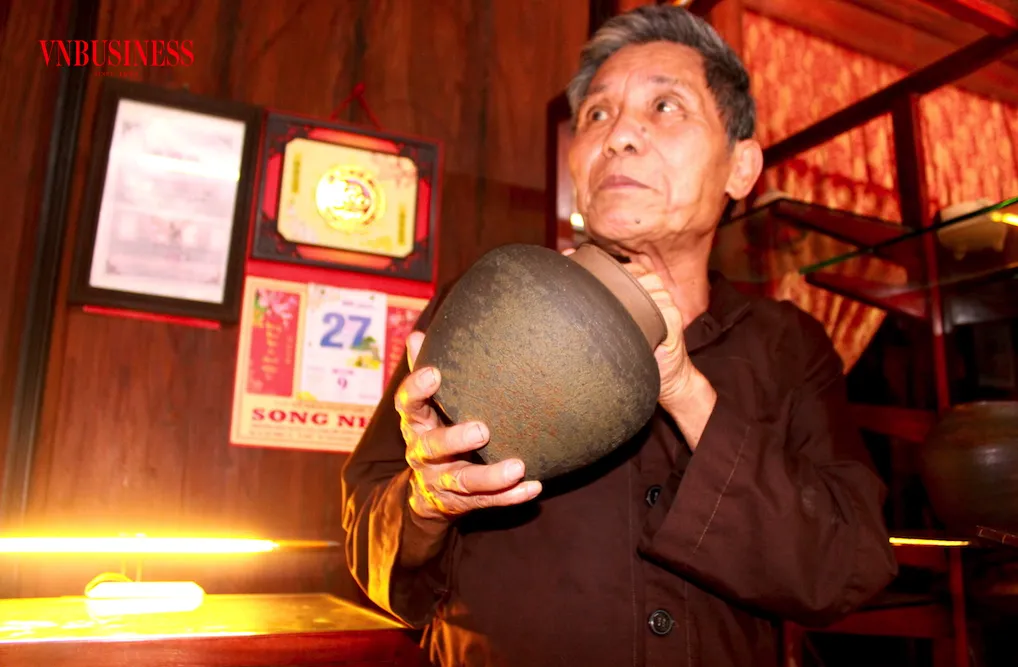Central Vietnam, a land of sunshine and wind, is not only famous for its long beaches and majestic natural landscapes but also a place that preserves invaluable cultural and historical values. Ancient and tranquil villages, nestled by poetic rivers or at the foot of green mountains, still retain their traditional beauty, inviting visitors to explore and experience. Let’s join “Du lịch khắp thế gian” on a journey back in time, discovering the “ancient villages of Central Vietnam” that still retain their old charm.
From mossy brick roads and time-worn tiled roofs to ancient wooden houses, each ancient village in Central Vietnam carries its own story, a unique cultural identity. Here, visitors not only admire the beauty of ancient architecture but also have the opportunity to immerse themselves in the peaceful life of local people, learn about long-standing customs and traditions, and enjoy local specialties imbued with the flavor of the homeland.
Phuoc Tich Ancient Village, Hue: Historical Witness by the O Lau River
Phuoc Tich ancient village, located in Phong Dien district, Thua Thien Hue province, is known as one of the most beautiful ancient villages in Vietnam. With a history of nearly 600 years, Phuoc Tich still retains the unique architecture of traditional Hue-style stilt houses, ancient brick roads, lush green tea fences, and mossy tiled roofs.

Stepping into Phuoc Tich, visitors feel like they are entering another world, where time seems to stand still. The space is peaceful and quiet, with only the chirping of birds, the rustling of leaves, and the gentle laughter of local people. The ancient houses, with their unique architecture and sophisticatedly carved patterns, are a testament to the talent and creativity of ancient artisans.
A special feature of Phuoc Tich is its close connection to the gentle O Lau River. The river is not only a source of irrigation water for the fields but also an important transportation route, connecting Phuoc Tich with neighboring areas. In addition, the O Lau River brings Phuoc Tich a poetic and lyrical beauty that captivates people’s hearts.
According to historical records, Phuoc Tich village was founded in 1470 by Mr. Hoang Minh Hung, a deputy general under King Le. After defeating the Chiem Thanh army, he returned to his hometown in Nghe An, recruited 12 more clans to come here to reclaim land and establish hamlets. Initially, the village was named Cam Quyet, then changed to Phuc Giang, Hoang Giang, Phuong Giang, and finally renamed Phuoc Tich by King Gia Long with the wish that the people would accumulate blessings for their descendants.
Today, despite many historical upheavals, Phuoc Tich ancient village still retains its traditional cultural values, becoming an attractive destination for domestic and international tourists. Coming to Phuoc Tich, visitors not only admire the beauty of ancient architecture but also have the opportunity to learn about the history and culture of the ancient capital of Hue.
Miniature Duong Lam in Central Vietnam: Ancient Ruong Houses
The ancient Ruong houses in Phuoc Tich are all over 100 years old and are mostly still preserved in their original architecture. Stepping through the gate, visitors will admire the sturdy wooden frames, intricately carved columns and beams, and household items imbued with the mark of time.

Mr. Le Trong Dien, grandson of Mr. Le Trong Kiem, said that King Gia Long named the village Phuoc Tich, and every year, during the King’s dedication ceremony, villagers had to make a clay pot to cook rice for the King (called “om ngu”). These ancient “om ngu” pots of Phuoc Tich village are made from special brown clay, fired through fire, creating a characteristic dark brown color. This is a type of unglazed pottery, durable, smooth, and sophisticated.
Currently, Phuoc Tich has 27 ancient houses and 10 clan temples (out of a total of 117 houses in the village), mostly three-compartment, two-lean-to Ruong houses. Each house has a large garden of about 1,000 – 1,500m2, planting seasonal fruit trees, the most common of which is the fig tree, usually planted in the corner of the garden.

In addition to ancient Ruong houses, Phuoc Tich also preserves many other cultural values such as traces of ancient Cham culture, the village organization institutions of Vietnam, and a system of religious and belief structures serving the community’s cultural life.
Hoi An, Quang Nam: Intersection of East-West Culture
Hoi An, an ancient city located on the banks of the Thu Bon River, Quang Nam province, is one of the most famous tourist destinations in Vietnam. With unique architecture, a harmonious blend of Vietnamese, Chinese, Japanese, and Western cultures, Hoi An has been recognized by UNESCO as a World Cultural Heritage Site.
Coming to Hoi An, visitors will admire ancient houses with mossy tiled roofs, narrow streets with shimmering lanterns, and historical and cultural relics such as the Covered Bridge, Phuc Kien Assembly Hall, Tan Ky Old House, and more.
Hoi An is not only an attractive tourist destination but also an important cultural and historical center of Vietnam. This place was once a bustling trading port, a trading hub for merchants from all over the world. The intersection of East-West culture has created a unique, diverse, and colorful Hoi An.
Thanh Ha Pottery Village, Quang Nam: Preserving the Essence of Traditional Pottery
Located not far from Hoi An ancient town, Thanh Ha pottery village is one of the famous traditional craft villages of Quang Nam province. With a history of over 500 years, Thanh Ha pottery village still retains unique pottery-making secrets, creating exquisite pottery products imbued with Vietnamese culture.
Coming to Thanh Ha pottery village, visitors will witness firsthand the handmade pottery making process of artisans, from choosing clay, kneading, shaping, to firing pottery. Visitors can also try their hand at making pottery, creating unique products with personal imprints.
Thanh Ha pottery products are very diverse in designs and styles, from everyday household items such as bowls, plates, teapots, cups, to decorative products such as statues, reliefs, and ceramic paintings. Thanh Ha pottery is not only consumed domestically but also exported to many countries around the world.
Conclusion
Central Vietnam is a treasure trove of culture and history with ancient villages, historical and cultural relics, and traditional craft villages. The “ancient villages of Central Vietnam” are not only attractive tourist destinations but also living museums, preserving the cultural and historical values of the nation. Come to Central Vietnam, explore the ancient villages, and feel the simple and familiar beauty of this land.

Hopefully, through this article, “Du lịch khắp thế gian” has brought readers useful information and interesting suggestions for exploring the ancient villages of Central Vietnam. Wish you a happy and meaningful trip!